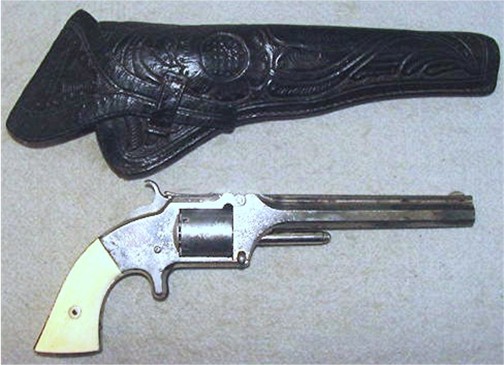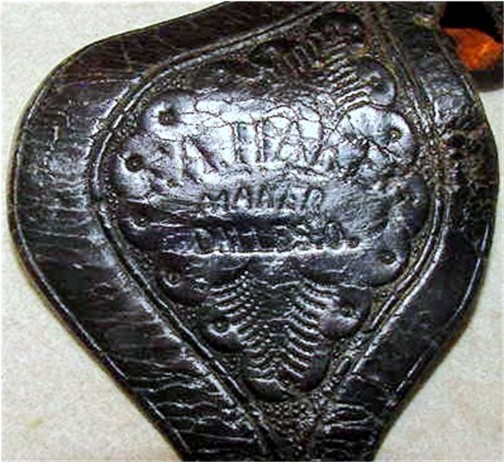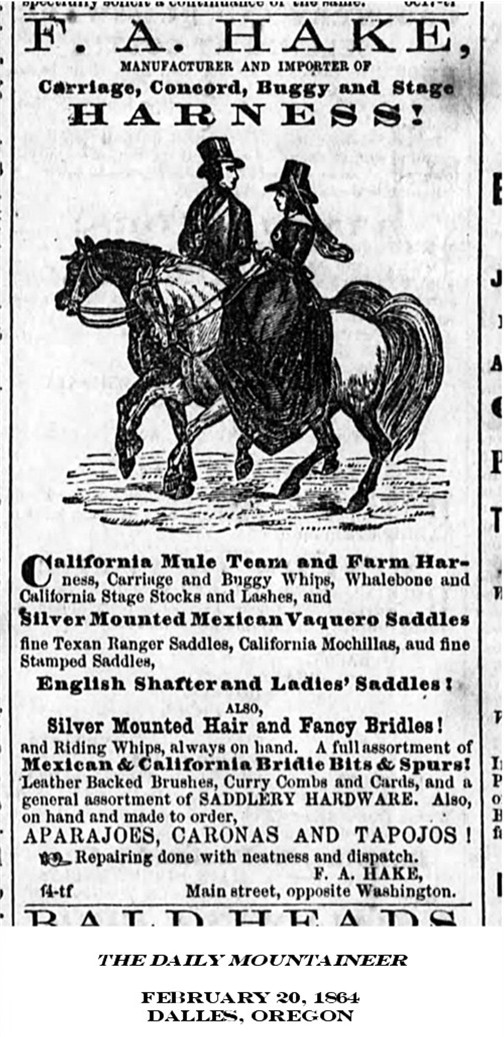|
SMITH & WESSON MODEL 2 ARMY REVOLVER - IVORY
GRIPPED WITH ORIGINAL MATCHING HOLSTER – MAKER MARKED
F.A. HAKE – ca. 1860’s DALLES, OREGON SADDLER –
FANTASTIC EARLY OREGON TRAIL - NW FRONTIER SET:
This nickel plated, ivory gripped Smith & Wesson Model 2
Army Revolver, serial number 11908, is accompanied by
its original very nice early-style flapped civilian
holster, fully carved and tooled, and bearing the very
rare saddler’s mark of “F.A. HAKE, MAKER, DALLES, O.”.
 
Relatively unknown, and with reportedly few examples of
his work surviving, nonetheless by the 1860’s F. A. Hake
was a well established saddler and leather worker who
was operating what from all appearances was a thriving
business on Main Street in The Dalles, Oregon. Hake’s
elaborate advertisements were published on a weekly
basis – at least through 1865 - in the Dalles
Weekly Mountaineer newspaper, calling prospective
buyers’ attention to his extensive offerings of high
grade saddles; carriage, stagecoach, mule team and farm
harness; bridles, bits, and a variety of other leather
products. The offerings listed in the advertisement
broadsides indicates his work was heavily influenced by
the saddlery styles originating in California – perhaps
due to the preferences of his clientele. Very little
beyond these advertisements is known about Hake, to
include even his full first and middle names – “F.A.”
being the only manner in which his name appears in the
references found to date. There is a legal notice which
was published in the August 20TH, 1865
edition of the Dalles Weekly Mountaineer newspaper
announcing the dissolution of the partnership of F.A.
Hake and C. M. Rohr who had been doing business in Boise
and Idaho City, Idaho Territory, but no other details of
this partnership have been located.

The Dalles, Oregon, situated on the banks of the
Columbia River, was an established Native American
trading site long before the Lewis and Clark Expedition
situated their campsite on the location in October of
1805. In the years to follow as the watercourse became
one of the primary thoroughfares of the fur trade, the
name evolved from the French voyageurs’ reference to the
rapids in that stretch of the river. Major trading
companies such as Hudson Bay, the Northwest Company and
the American Fur Company established trading posts on
the site in the first twenty five years of the century,
and by the 1840’s the westward bound emigrant trains
were following the Oregon Trail to its western terminus
on the streets of The Dalles, by that time a well
founded city concentrated along the waterfront.
Incorporated as a city in 1857, and originally named
“Dalles”, the name was changed to “The Dalles” in 1860.
Hake’s maker stamp use of “DALLES” rather than “THE
DALLES” may indicate that his business, and the stamp,
may have predated this name change in 1860.
According to
Smith & Wesson production records, this particular
revolver – Serial Number 11908
- was manufactured in the first years of production,
certainly during the Civil War. It is known that a
Smith & Wesson No. 2, serial number 15702,
was sold to J.W. Storrs in New York City on December 9,
1863, so this particular pistol was manufactured well
before that date. This early manufacture date coincides
with the period of time F.A. Hake is known to have been
in the saddlery business in The Dalles during the
1860’s, and argues for this pistol and holster being
original to each other.
While showing signs of having been carried and fired
more than a few times, this Smith & Wesson has survived
the years in very good condition. The hammer and
trigger are mechanically crisp, the cylinder indexes
properly, and the barrel hinge is solid with only a very
minor amount of play. The cylinder also remains
properly indexed and locked in place after the hammer is
cocked, as opposed to the common problem frequently
encountered with these revolvers – that of a weakened
cylinder stop spring which allows the cylinder to
continue to rotate after the hammer is cocked.
Chambered for the .32 Rimfire Long cartridge, the top
flat of the 6” long barrel retains the fully legible
Smith & Wesson maker’s stamp, the bore is overall bright
with only minor patches of pitting, the rifling clear
and strong, and the chambers of the cylinder are
likewise bright with some minor light pitting.
The exterior metal surfaces
are in very good condition, retaining 80% or more of the
original nickel plating, with very minor spots of
pitting in isolated spots. Although not serial
numbered, the ivory grip panels appear to be original in
every way to this revolver, and are a feature consistent
with the nickel plated finish. The grip panels are in
excellent condition with no splits, cracks, or chips,
and they have a beautiful naturally aged patina.
The holster
presents in excellent condition, particularly in light
of its early vintage and that it was carried in an
active area of the far West frontier. The body of the
holster is formed to the revolver and from all
appearances the holster and revolver are original to
each other. The holster retains its full form,
including the integral flap with an elongated tab which
is secured under a small strap sewn to the face of the
holster. The body and flap of the holster is artfully
carved and stamped with an intricate floral pattern,
with the flap design incorporating the stamped maker’s
mark as described above. The body seam is fully intact
and strong. The toe of the holster retains its shape
and the carved design on the front and on the reverse,
there is a small wear spot where the holster wore
against the wearer’s leg. Of special note, especially
in light of the size and caliber of this revolver, there
is a pair of holes low on the reverse of the holster
body which was obviously intended for a leather thong to
tie the holster to the wearer’s leg. The man who
carried this set clearly intended to be ready to answer
the call should the occasion arise that he needed to
defend himself. The belt loop is full form and solidly
attached to the holster body. The leather surfaces are
generally smooth and bright with only minor flexing on
the flap and a few nominal carrying marks on the
reverse.
Overall, this unique and eye-catching pairing of this
ivory gripped nickel plated Smith & Wesson No. 2 and a
rare saddler identified holster from the early Northwest
frontier is indeed a special set which has survived the
years together in very respectable condition. Showing
evidence of having been carried and put to good use, it
is entirely possible that this set witnessed and likely
participated in more than its fair share of frontier
excitement without being abused or neglected.
(1015)
$5500
|

